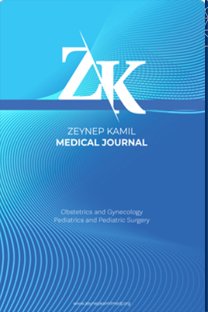Serum endocan concentration in women with placenta accreta
Serum endocan concentration in women with placenta accreta
___
- 1. Maldjian C, Adam R, Pelosi M, Pelosi M 3rd, Rudelli RD, Maldjian J. MRI appearance of placenta percreta and placenta accreta. Magn Reson Imaging 1999;17(7):965–71.
- 2. Warshak CR, Eskander R, Hull AD, Scioscia AL, Mattrey RF, Benirschke K, et al. Accuracy of ultrasonography and magnetic resonance imaging in the diagnosis of placenta accreta. Obstet Gynecol 2006;108(3):573– 81.
- 3. Lam G, Kuller J, McMahon M. Use of magnetic resonance imaging and ultrasound in the antenatal diagnosis of placenta accreta. J Soc Gynecol Investig 2002;9(1):37–40.
- 4. Ng EK, Tsui NB, Lau TK, Leung TN, Chiu RW, Panesar NS, et al. mRNA of placental origin is readily detectable in maternal plasma. Proc Natl Acad Sci USA 2003;100(8):4748–53.
- 5. Tjoa ML, Jani J, Lewi L, Peter I, Wataganara T, Johnson KL, et al. Circulating cell-free fetal messenger RNA levels after fetoscopic interventions
- of complicated pregnancies. Am J Obstet Gynecol 2006;195(1):230–5. 6. Lo YM, Chiu RW. Prenatal diagnosis: Progress through plasma nucleic acids. Nat Rev Genet 2007;8(1):71–7.
- 7. Maron JL, Bianchi DW. Prenatal diagnosis using cell-free nucleic acids in maternal body fluids: A decade of progress. Am J Med Genet C Semin Med Genet 2007;145C(1):5–17.
- 8. Lassalle P, Molet S, Janin A, Heyden JV, Tavernier J, Fiers W, et al. ESM-1 is a novel human endothelial cell-specific molecule expressed in lung and regulated by cytokines. J Biol Chem 1996;271(34):20458–64.
- 9. Sarrazin S, Adam E, Lyon M, Depontieu F, Motte V, Landolfi C, et al. Endocan or endothelial cell specific molecule-1 (ESM-1): A potential novel endothelial cell marker and a new target for cancer therapy. Biochim Biophys Acta 2006;1765(1):25–37.
- 10. Bechard D, Meignin V, Scherpereel A, Oudin S, Kervoaze G, Bertheau P, et al. Characterization of the secreted form of endothelial-cell-specific molecule 1 by specific monoclonal antibodies. J Vasc Res 2000;37(5):417–25.
- 11. Schuitemaker JH, Cremers TI, van Pampus MG, Scherjon SA, Faas MM. Changes in endothelial cell specific molecule 1 plasma levels during preeclamptic pregnancies compared to healthy pregnancies. Pregnancy Hypertens 2018;12:58–64.
- 12. Milosevic-Stevanovic J, Krstic M, Radovic-Janosevic D, Stefanovic M, Antic V, Djordjevic I. Preeclampsia with and without intrauterine growth restriction-Two pathogenetically different entities? Hypertens Pregnancy 2016;35(4):573–82.
- 13. Sánchez-Aranguren LC, Prada CE, Riaño-Medina CE, Lopez M. Endothelial dysfunction and preeclampsia: Role of oxidative stress. Front Physiol 2014;5:372.
- 14. Duzyj CM, Buhimschi IA, Laky CA, Cozzini G, Zhao G, Wehrum M, et al. Extravillous trophoblast invasion in placenta accreta is associated with differential local expression of angiogenic and growth factors: A cross-sectional study. BJOG 2018;125(11):1441–8.
- 15. Murthi P, Sarkis R, Lim R, Nguyen-Ngo C, Pratt A, Liong S, Lappas M. Endocan expression is increased in the placenta from obese women with gestational diabetes mellitus. Placenta 2016;48:38–48.
- 16. Chang X, Bian Y, Wu Y, Huang Y, Wang K, Duan T. Endocan of the maternal placenta tissue is increased in pre-eclampsia. Int J Clin Exp Pathol 2015;8(11):14733–40.
- 17. Aksoy M, Aksoy AN, Laloglu E, Dostbil A, Celik MG. Umbilical cord blood endocan levels according to the delivery mode. Clin Exp Obstet Gynecol 2015;42(6):776–80.
- 18. Harper LM, Odibo AO, Macones GA, Crane JP, Cahill AG. Effect of placenta previa on fetal growth. Am J Obstet Gynecol 2010;203(4):330. e1–5.
- 19. Yeniel AO, Ergenoglu AM, Itil IM, Askar N, Meseri R. Effect of placenta previa on fetal growth restriction and stillbirth. Arch Gynecol Obstet 2012;286(2):295–8.
- 20. Ying H, Lu Y, Dong YN, Wang DF. Effect of placenta previa on preeclampsia. PLoS One 2016;11(1):e0146126.
- ISSN: 1300-7971
- Yayın Aralığı: Yılda 4 Sayı
- Yayıncı: Ali Cangül
Foreign body in esophagus of children with previous esophageal surgery history
Ayşenur CELAYİR, Olga Devrim AYVAZ, Bekir ERDEVE
Serum endocan concentration in women with placenta accreta
Önder TOSUN, Evrim BOSTANCI, İsmail DAĞ, Enis ÖZKAYA, Çetin KILIÇÇI, Ahmet ESER, Çiğdem YAYLA ABİDE, İlter YENİDEDE
Nurdan EROL, Merve ÖZEN, Abdülkadir BOZAYKUT
Anaphylaxis that develops following application of egg white on an area of burn
Zeynep Şengül EMEKSİZ, Serap ÖZMEN
Çağatay NUHOĞLU, Nevzat Aykut BAYRAK, Erkan YETMİŞ
Ahmet KALKIŞIM, Gökhan ÇELİK, Betül ÖNAL GÜNAY, Cenap Mahmut ESENÜLKÜ
Negative pressure wound therapy in gynecological oncology
Sevgi KOÇ, Cihat Murat ALINCA, Taner TURAN, Caner ÇAKIR, Dilek YÜKSEL, Çiğdem KILIÇ, Nurettin BORAN, Günsu KİMYON CÖMERT, Fulya KAYIKÇIOĞLU
İbrahim KALE, Cumhur Selçuk TOPAL
Comparison of outcomes of frozen-thawed transfer of day 5 blastocysts and day 6 blastocysts
